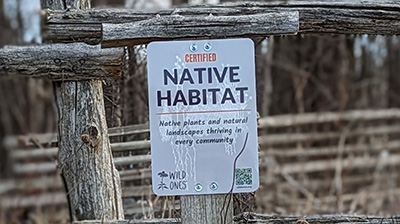Help Monarch Butterfly Conservation through Community Science Monitoring
The migration of monarch butterflies (Danaus plexippus) is a spectacular natural phenomenon. You can be a part of an expanding community science initiative in North America focused on monitoring the status of monarchs. Wild Ones, in collaboration with the Monarch Joint Venture (MJV), invites you to join as a community scientist through our Wild for Monarchs campaign.
Community Science Involvement: Community scientists are volunteers who work alongside professional researchers to gather essential data for scientific and conservation purposes. By engaging in scientific research and monitoring, we can enhance our understanding of monarch butterfly biology, population trends, diseases, and habitat availability—factors that influence the monarch’s survival.
People of all ages and experience levels are welcome to get involved! Many community science programs offer training and participation comes with only a possible minor supply cost, such as tags. The primary investment is time.
Keep reading to find out more about community science programs that are associated with partners of the Monarch Joint Venture, just like Wild Ones.
Getting Involved: To take part, reach out to your local Wild Ones chapter by visiting https://wildones.org/chapters/. If you have questions, feel free to call (920) 730-3986 or email [email protected]
3 Habitat-Focused Monarch
Community Science Initiatives
1. Journey North:

Participate in a global education program by reporting your observations of seasonal monarch migration and habitat. Contribute to real-time online maps available at https://journeynorth.org/monarchs. Report sightings to track the monarchs’ migration to and from their overwintering grounds. Your observations will be integrated into interactive maps, and weekly monarch activity updates will be accessible.
What you can observe and report changes seasonally. Fall 2023 focuses on reporting:
● Monarch Adult Sighted
● Monarch Egg Sighted and/or Monarch Larva Sighted
● Monarch PEAK Migration
● Monarch Fall Roosts
● Observations of interesting behaviors
● Milkweed Sighted
About Journey North
Journey North is a crowdsourced, participatory science program of the University of Wisconsin-Madison Arboretum. Thousands of volunteers across North America contribute observational data that help track wildlife migration and seasonal change. Their mission is to foster scientific understanding, environmental awareness, and land ethic.
2. Western Monarch Milkweed Mapper

Collect data that aids researchers in determining distribution, phenology, and conservation requirements for monarchs and milkweeds. The focus of this project is to learn more about the areas monarchs use for breeding and migrating in the Western U.S., which is less well understood than the Eastern U.S. Users create an account and then submit sightings of monarchs and/or milkweeds in eleven western states. These sightings feed into a larger milkweed and monarch occurrence database, which contains tens of thousands of records pulled from herbaria, research datasets, state and federal survey efforts, and other community science programs.
You can participate by simply setting up an online account, uploading photographs of monarchs and milkweed, and identifying your sighting using Western Monarch Milkweed Mapper’s helpful guide of over 40 milkweed species in the Western U.S.
About the Western Monarch Milkweed Mapper
This Western Monarch Milkweed Mapper is part of a collaborative effort to map and better understand monarch butterflies and their host plants across the Western U.S. Community. Community-supplied data will improve our understanding of the distribution and phenology of monarchs and milkweeds, identify important breeding areas, and help us better understand monarch conservation needs. Project partners include the Idaho Department of Fish and Game, Washington Department of Fish and Wildlife, The Xerces Society for Invertebrate Conservation and funded by the National Fish and Wildlife Foundation and the U.S. Fish and Wildlife Service.
3. Monarch Larva Monitoring Project

Join community scientists from across the country to contribute to knowledge about monarch population dynamics and promote monarch and habitat conservation. Engage in observing the monarch’s life cycle and collecting long-term data on eggs, larvae, adults, and milkweed habitats. The goals of this project are to understand better how the monarch breeding population changes throughout the season and from year to year.
You will learn to:
● Collect data on monarch eggs and larvae in a monarch habitat site of your choice.
● Estimate milkweed density and describe the habitat site.
● Report observations to be used in real scientific studies.
● Report data online and visualize monarch activity at your monitoring site(s) via monarch density graphs.
● Compare your observations with those of other community scientists.
Training sessions are available in person and online. Project information is available through online training videos. Datasheets for recording observations are available online. Additional monitoring materials and supplies can be purchased through the Monarch Lab Store. http://monarchlab.org/store
About Monarch Larva Monitoring Project
The Monarch Larva Monitoring Project is a partnership of the Monarch Joint Venture and the University of Wisconsin-Madison Arboretum. Its mission is to better understand the distribution and abundance of breeding monarchs and inspire monarch conservation.
Wild Ones is a proud partner of Monarch Joint Venture

About MJV: The Monarch Joint Venture (MJV) is a non-profit organization that unites federal and state agencies, nonprofits, community groups, businesses, and academic programs to protect monarch butterflies and other pollinators. Through collaborative efforts, MJV implements science-based conservation actions, including education, habitat preservation, and scientific research. Wild Ones and MJV have forged a strong and collaborative partnership based on their shared recognition of the pivotal role that native plants play in providing essential resources for monarchs and other pollinators at every stage of their lifecycle. Learn more about our Wild for Monarchs program.

